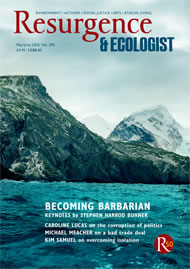Wendell Berry and Gary Snyder live on opposite sides of the continental United States, or Turtle Island, as Snyder calls it. Though both are poets, writers and founding members of the counterculture and environmental movements, their differences are as significant as their similarities. Berry, who lives and works his hillside farm near his grandfather’s land in Kentucky, is a traditional farmer who thinks in terms of long-term, respectful use of land – in the first letter in this book he writes, “We decided to farm with horses instead of a tractor.” Snyder, at the time this correspondence starts, had just settled with his family in the Sierra Foothills in northern California. His orientations are towards the lessons that can be learned from wilderness.
Snyder is a practising Zen Buddhist, having lived and studied in a monastery in Japan. He draws strongly on oriental and Native American influences. Berry, while uncomfortable with established churches, is firmly Christian in orientation and describes himself at one point as “an apologist for the west”. It is these differences, which the two writers approach firmly yet with mutual respect, that make these letters so engaging.
When the correspondence starts in 1973, they are aware of each other’s work but have not yet met. The letters trace the development of a deep friendship. Over the decades, they visit each other’s homes, critique drafts of writing, and share platforms at conferences and poetry readings (including a visit to England for the Schumacher Lectures). They explore their views on ecology, wilderness and farming, religion and spirituality, politics, capitalism and economics; they get to know each other’s families and share the joys and sorrows that inevitably arise over time.
Wendell Berry and Gary Snyder are men whom many regard with great respect. I myself have drawn on their prose and poetry extensively, appreciating their inspiration and clarity of thought. So it is fascinating to see that behind this authoritative image are two men struggling to make sense of a changing world and seeking to be of service where they can. It is also humanising to see how these literary figures are also practical men: their philosophical discussions are interspersed with comments about the weather, floods, lambing, building ponds, managing fire risk, and so on.
Together they engage in an energetic, challenging, yet respectful mutual inquiry. To pick one example, Snyder writes a detailed critique of a draft of Berry’s Preserving Wildness. He starts by saying, “There is a lot there that I question,” but ends with “Well, that was fun to read and fun to write down some responses.” The debate centres on the question of land use: Berry writes, “Deep Ecology seems to me to be comfortable with the issues of preservation, uneasy with the issue of use.” Then Berry appreciates a draft of The Etiquette of Freedom, writing that Snyder is a “true teacher”. A few letters on he is more combative, pointing to places in The Practice of the Wild where he worries that Snyder is making sweeping statements that need untangling: he thinks Snyder sees agriculture as “too exclusive of wildness” and that Snyder’s phrase “the ideology of monotheism” is far too “general and simple”. It’s a lively debate. As Berry writes, “I think it would be surprising and disappointing if we agreed more than we do. If we agreed about everything, what would we have to say to each other? I am for conversation.”
Chad Wrigglesworth has done an excellent job in editing these essays, and has written an illuminating introduction to Snyder and Berry and their correspondence. The book will be invaluable to students of these men and of the environmental movement. But in some ways it is an awkward book to read. Many of the letters refer to, or were accompanied by, poems and articles by the principals and others, and of course, the book would be impossibly long if all these were included; but without them the reader does often feel left hanging. I think it might have been a better book for the general reader if it had offered a portrait of the friendship drawing on the letters, other written material and the interviews Wrigglesworth conducted.
Nevertheless, I found in these letters a feeling of delightful companionship. Berry and Snyder offer us a model of convivial masculinity, an exemplary relationship between two men who are grounded in their own practical lives and enjoy reaching out in friendship while being willing to disagree heartily.






